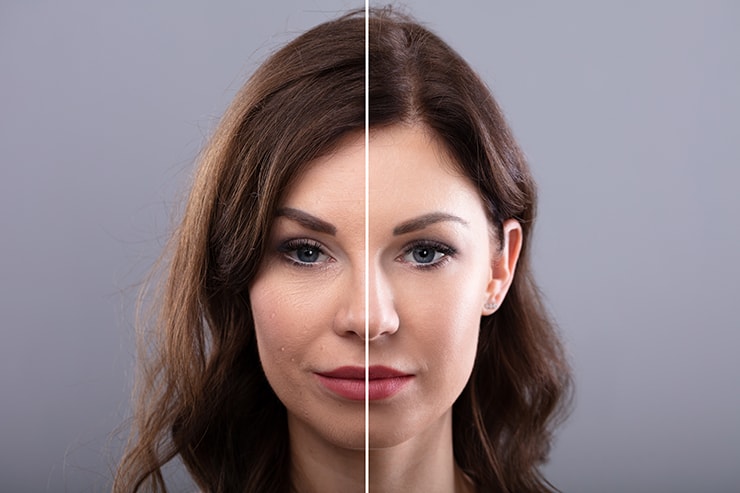Jaw pain can be a troubling and disruptive experience. If the pain is severe, it can stop you in your tracks. Even less severe pain can make it hard for you to go about your daily activities. It can make you give up certain hard-to-chew foods, forcing you to eat a less healthy–and sometimes less enjoyable–diet.
Can jaw pain on one side be TMJ? Yes.
Temporomandibular joint disorders (TMJ or TMD) often develop symmetrically, in both jaw joints at the same time. However, it is possible for people to develop the disorder and experience symptoms on just one side of the head. However, as the condition progresses, it will likely spread to affect the other joint as well.

Other Potential Causes of Jaw Pain on One Side
TMJ is one of several common causes of jaw pain on one side. You should also consider other potential explanations of jaw pain on one side to determine whether you should seek out a TMJ dentist in Sydney. Consider whether your jaw pain might be caused by:
- Jaw trauma
- Dental problems
- Sinusitis
Jaw trauma can lead to ongoing jaw pain. This ongoing jaw problem can, over time, worsen to become TMJ. However, you might experience symptoms like jaw pain long before the condition meets the clinical definition of TMJ. It’s best to talk to a dentist trained in taw treatment when symptoms first appear to avoid more serious problems later.
Dental problems can often seem like jaw problems. In particular an infected tooth can cause pain that radiates out from the tooth. It can sometimes seem like it’s coming from your jaw joint. Watch for other symptoms of dental problems. This might include a tooth that is visibly damaged or discolored, sores on your gums, discharge from the tooth and/or gums, and bad breath.
Sinusitis can make pain that seems like it’s coming from your jaw joint as well. Sinuses are hollow spaces underneath your face. When infected, they can become inflamed, leading to pain in or near your jaw joint. Sinusitis symptoms include pressure in your face, around or below the nose, especially, nasal congestion, nasal discharge, fatigue, and fever.
If you can eliminate other potential causes, seek treatment for TMJ. This is especially true if your jaw pain is muscle soreness or pain in the joint.
Why TMJ Might Develop on Just One Side
The temporomandibular joints are supposed to work as a matched pair, balancing forces in a way that maintains healthy function over the long term. So how do they get unbalanced?
Usually, trauma is the cause of imbalance. If you receive a blow to one side of the face, you might experience damage to the jaw joint, which can cause dysfunction. Of course, sometimes this isn’t the side that develops dysfunction. After you start to experience jaw pain on one side, it’s not uncommon to favor that side. You might consciously chew on the other side of your mouth, which can lead to jaw damage and sore jaw muscles there.
Another reason for imbalance in jaw joint damage is simply that you might strongly favor one side of your jaw over the other. Similar to handedness, some people have a tendency to chew mostly on one side of their mouth, which can stress the jaw joint, leading to dysfunction. With a habit like gum chewing, it’s possible to do a lot of damage to your jaw joint when favoring one side over the other.
Unconscious clenching and grinding (bruxism) can also be governed by your tendency to favor one side over the other. Damage can quickly escalate from clenching and grinding. That’s because you might clench with 50 times the force or more than you normally chew with, and you have hours at night to clench uninterrupted .
If you are strongly right-handed, you might be more likely to develop a sore jaw on the right. You might unconsciously put objects into your mouth on the right side, and biting down on these pens, pencils, fingernails, and other objects can damage your right jaw joint (not to mention your teeth!).
TMJ Symptoms Will Likely Spread
So, yes, it is possible to develop TMJ on just one side of the face. However, the condition probably won’t stay isolated like that. After all, the two joints do work together, and what affects the one will affect the other, though often in an inverse way. If you are compressing one jaw joint, you might be expanding the other. This causes stress, too, though it might not be obvious at first.
When you bite, chew, and grind on one side of the mouth, you can cause the teeth to wear down there much faster than on the other side. This can cause your jaw to tilt visibly, creating an uneven facial appearance. Not only that, but eventually the stretching force will lead to dysfunction in the decompressed joint.
You might also spread dysfunction in the same way you developed it on the first side: by compensating. If one jaw joint is causing you pain such as headaches, you can switch over to the other side to avoid the pain. This might work, but over time both joints can develop TMJ symptoms.
Correct Problems Before Symptoms Spread
Fortunately, TMJ is treatable. And if you’re experiencing symptoms on just one side of your face, treatment can head off the spread of those symptoms.
If you are looking for treatment of TMJ in the Sydney area, please call (02) 9686 7375 today for an appointment with a dentist at My Hills Dentist in Baulkham Hills.

